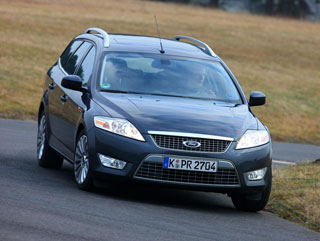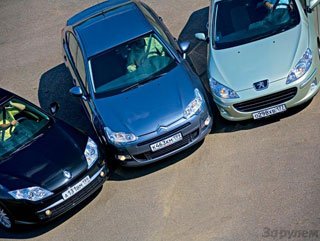PEUGEOT 407 test drive since 2004 sedan
Family value
He was waiting for a long time. Everyone was worried about the question: what will be the successor of Peugeot 406, which has become a classic of the genre? And then, finally, the 407th in the game.According to the creators, Peugeot 407 will open an era of changes in the M2 segment, which, from the point of view of the company's designers, requires a thorough shake. The model was developed on the 3 Peugeot-Citroen platform, which is the foundation for car segments M2 and N.
In the appearance of the 407th there are fresh motives that will sound in future Peugeot models. But this family sedan is conceived not only as a revolutionary, but also as a successor to the success of the 406th, famous for predictability, excellent dynamics and handling. The designers of the company tried to surpass themselves, and in a number of constructive indicators they succeeded, for example, the frontal resistance coefficient in the 407th is 0.29, and in the 406th-0.32. As far as the car will be commercially successful, time will tell, but 1.5 billion euros invested in the project speak for themselves. The planned volume of annual sales is 300,000.
The appearance of the novelty is really unusual. A huge, by current standards, the front overhang is immediately striking. People who have positively evaluated such a design move reasonably believe that it allowed the car to make the car safer, increase the space for the driver and the front passenger. Opponents, however, pay attention to the fact that because of this it was necessary to give a cross. The car is offered in versions of Confort, Executive, Sport and Griffe. Almost everyone agrees with the fact that the salon was a success. It is comfortable here: fashionable finishing materials, high -quality plastics, wood inserts. In addition to traditional glove box, door pockets and holders for cans, the driver has boxing for documents and phone.
Far from an extra part of a family car - trunk. In the 407th, its capacity reaches 468 liters. By the way, the width of the cargo compartment (1,100 mm) here is the largest in the segment - due to the use of a new multi -leaf rear suspension with lying shock absorbers. In the deepening of the trunk, a full -size reserve is placed.
The backs of the rear seats are folded in relation to 1/3 and 2/3. There is a hatch for skis.
For all that, the passengers space remained the same as in the 406th, and people above 180 cm there are crowded. But the driver's seat is more convenient, shifted back and forth by 24 cm and rises by 5 cm. The front seats pillows are extended by 2 cm. Active head restraints with a system that eliminates the deflection of the body and discarding the head during collision, are adjustable in height and angle of inclination. The steering column, of course, also: 4 cm in height and length. The last installations of seats, a steering column and mirrors are automatically remembered.
Depending on the version, the machine is equipped with a power steering with a pumping variable, a hydroelectric power system and (only on modifications with a V6 engine) with a hydraulic wiper whose control unit processes data on speeds, twisting of the crankshaft, angles of rotation of the steering wheel and, in accordance with the information received, regulates the force. On the steering wheel.
The standard includes halogen headlights with double reflectors and foglights in the apron of the front bumper, xenon is the option.
One of the fundamental family values \u200b\u200bis security. It was on her that the designers bet. They are sure that the 407th will receive five stars at the Euro NCAP Crash tests and two on a pedestrian test. Active safety is ensured by the system of dynamic stabilization of the new generation (ESP), which includes ABS, the anti -boogging system (ASR) and the emergency slowdown system (AFU). A large diameter of the brake discs, up to 330 mm, increases the efficiency of braking. Each wheel is under the control of the interacting systems - an electronic brake force regulator (Ref) and the new SVS system, which allows to independently regulate the braking of the right and left wheels. There is also CDS that monitors stability.
Among the passive safety systems, we note the programmable owner of the automatic locking system, which triggers 10 km/h. The belts are equipped with an inertial coil and a three -point mount. In a collision, pyrotechnic pretensors and frontal eirbegs act synchronously.
By the way, the number of airbags can reach nine, although there should be six of them according to the M2 standard. The pillow, protecting the driver’s knees, migrated from the N. segment when the front eirbeg is triggered by the pressure and the volume of the air supplied depend on the impact and weight of the driver. Side pillows are also provided. The passenger next to the driver is protected by a 120-liter front and 10-liter side pillows. For sitting from behind - a 23 -liter air bag in the back of the front seat. In addition, the side pillows are hidden in the rear door panels.
The 407th was the first car of the group that has a tire pressure control system. It is included in the standard of executive, Sport and Griffe and is made by order of the Confort version. The system prevents the driver about the pressure in the tire below the permissible norm and gives a signal about the stop. With a sharp drop in pressure, the signal of the immediate stop sounds.
The car is equipped with four gasoline engines. It opens a gamma 1.8-liter 16-valve four-cylinder engine with a capacity of 117 hp, compliance with a five-speed manual gearbox. Behind it is a two-liter 136-horsepower unit with a four-speed Automatic Tipstronics box or with five-speed mechanics. The next motor is 2.2 in 160 hp with six -speed mechanics or the same four -speed automatic. A 3-liter 211-horsepower engine with 6 ACP is crowned. There are two diesels so far: 1.6 and 2.0 (110 and 136 hp, respectively).
On the go, I managed to try two cars: with a 2.2 gasoline and a mechanical 6-speed KP in executive and Sport executions, as well as an option with a 3-liter engine and automatic machine. Most likely, versions 2.2 will be more interesting to the Russian consumer, since this motor is elastic, burden, gives the car the optimal dynamics and has a power supply. A new multi -link rear suspension provides excellent stability in corners. The only thing that spoils the impression a little is the smeared gear shift in a mechanical box.
On a good road, the 407th is controlled perfectly. The steering wheel is quite informative, with a clear zero. The suspension makes it clear that the car is intended specifically for good roads. She regularly works out the unevenness of the autobahn at all speeds, and you notice this only by changing the nature of the sounds. But the 407th soil coating does not cope so confidently that, however, usually for modern machines.
The Sport version differs from Executive by the presence of a sports driver’s seat, the suspension setting, the best dynamic characteristics and equipment. Justifying the name, she really allows you to feel like an athlete - exactly as much as possible at the wheel of a family sedan.
A three-liter engine and a six-speed machine make the 407th not only more dynamic, but also at the same time imposing and predictable, something similar to American cars. Someone will probably not like this, however, we recall that before us the model is not sports, but family; Stability has always been far from the last among family values \u200b\u200b...
Cars with 4-cylinder gasoline engines 1.8, 2.0, 2.2 and 6-cylinder V-shaped 3.0 will be supplied to us.
Technical characteristics of Peugeot 407 2.2 (1.8)
The body is a sedan
The number of places - 5
Equipped mass, kg - 1480
Dimensions, mm:
- length - 4676
- width - 1811
- Height - 1445
Base, mm - 2725
The track of the wheels (front/rear), mm - 1560/1526
Maximum speed, km/h - 200
Acceleration time to 100 km/h, C - 10.1 (12.9)
Control consumption of fuel, l/100 km:
- City cycle - 12.9 (11.3)
- suburb - 6.8 (6.0)
- mixed - 9.0 (7.9)
Engine:
- type - gasoline, in -line, 4 -cylinder
- working volume, cm3 - 2230 (1749)
- Power, L.S. at MIN -1 - 160/5650 (116/5500)
- torque, N.M at min -1 - 217/3900 (163/4000)
Transmission - 6 MKP (5MKP)
Tire size - 215/55R17
Wheel suspension:
- front - two -winged
- rear - multi -link
Brakes (front, rear) - disk
Price, $ - 30450 (23900)
Text: Konstantin Shlyakhtinsky
Source: Magazine 5 wheel [07/2004]
Video Crash tests Peugeot 407 since 2004
PEUGEOT 407 test drive since 2004
PEUGEOT 407 Crash Test since 2004
Krassh Test: Detailed Information34%
Driver and passengers
15%
Pedestrians
39%
Children-passengers











